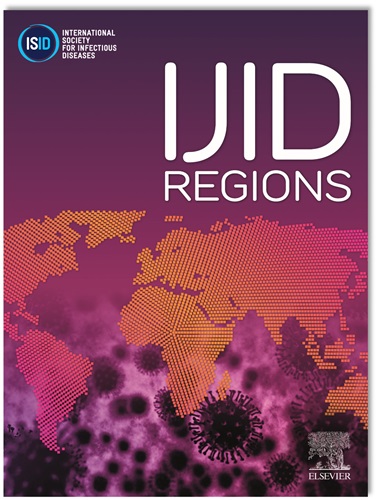最初表现为痛风性关节炎引起脚趾感染:一例罕见病例报告。
IF 4.3
2区 医学
Q1 INFECTIOUS DISEASES
引用次数: 0
摘要
原鞘菌是一种机会致病性微藻属,可引起人类和动物的原鞘病,表现为皮肤病变或弥散性/全身性感染。本文报告一例罕见的威氏原囊菌脚趾感染病例,患者为78岁中国男性,最初表现为痛风性关节炎。患者从事养鱼工作,经常接触水,有带状疱疹和高血压病史。三年来,他在双侧第一跖趾关节反复出现红斑、肿胀和疼痛,没有可识别的诱因。在过去的一个月里,症状恶化,导致疑似痛风入院。体格检查显示右脚1厘米溃疡,深红色肉芽组织基底,延伸4厘米深。周围皮肤红斑、肿胀、渗液,明显触痛。血清尿酸正常(354 μmol/L),中性粒细胞升高(82.1%)。MRI提示右脚可能有痛风性关节炎,但未见明显的尿酸结晶沉积。5天后,重新评估显示白细胞介素水平显著升高(IL-6 2500 pg/mL, IL-8 157.29 pg/mL),表明新的炎症反应强劲,局部症状没有明显改善。同时,深层组织取样和微生物学调查(包括组织病理学、血琼脂培养、荧光染色、基质辅助激光解吸/电离-飞行时间(MALDI-TOF)质谱)和内部转录间隔(ITS)测序证实了P. wickerhamii感染。改用伊曲康唑治疗,5天内症状好转,出院。该病例突出了维克氏假体感染的可变、伪装和潜在的严重临床表现。它强调了在疑似“痛风”伴持续性深溃疡病例中提高微生物筛查意识的重要性,特别是对有相关职业或环境暴露史的个体,特别是血清尿酸正常的个体。深层组织取样明确诊断是至关重要的,以避免经验性皮质类固醇治疗,这可能加剧机会性感染。本文章由计算机程序翻译,如有差异,请以英文原文为准。
Prototheca wickerhamii causing toe infection presenting initially as gouty arthritis: A rare case report
Prototheca, a genus of opportunistic pathogenic microalgae, can cause protothecosis in humans and animals, manifesting as cutaneous lesions or disseminated/systemic infections. This report describes a rare case of Prototheca wickerhamii toe infection in a 78-year-old Chinese male, presenting initially as gouty arthritis. The patient, who worked in fish farming with frequent water exposure, had a history of herpes zoster and hypertension. For 3 years, he experienced recurrent episodes of erythema, swelling, and pain in the bilateral first metatarsophalangeal joints without identifiable triggers. Symptoms worsened over the past month, leading to hospital admission with suspected gout. Physical examination revealed a 1 cm ulcer on the right foot with a dark red granulation tissue base, extending 4 cm deep. The surrounding skin was erythematous, swollen, exudative, and markedly tender. Laboratory findings showed normal serum uric acid (354 µmol/L) but elevated neutrophil percentage (82.1%). Magnetic resonance imaging (MRI) suggested possible gouty arthritis in the right foot, but no urate crystal deposition was evident. Five days later, re-evaluation revealed significantly elevated interleukin levels (IL-6 > 2500 pg/mL, IL-8 157.29 pg/mL), indicating a robust new inflammatory response, with no significant improvement in local symptoms. Concurrently, deep tissue sampling and microbiological investigations (including histopathology, blood agar culture, fluorescent staining, Matrix-Assisted Laser Desorption/Ionization - Time Of Flight (MALDI-TOF) mass spectrometry) and Internal Transcribed Spacer (ITS) sequencing confirmed P. wickerhamii infection. Antifungal therapy was switched to itraconazole, resulting in symptom improvement within 5 days, and the patient was discharged. This case highlights the variable, masquerading, and potentially severe clinical presentations of P. wickerhamii infection. It underscores the importance of heightened awareness for microbiological screening in cases of suspected “gout” with persistent deep ulcers, particularly in individuals with relevant occupational or environmental exposure histories, especially with normal serum uric acid. Deep tissue sampling for definitive diagnosis is crucial to avoid empiric corticosteroid therapy, which may exacerbate opportunistic infections.
求助全文
通过发布文献求助,成功后即可免费获取论文全文。
去求助
来源期刊
CiteScore
18.90
自引率
2.40%
发文量
1020
审稿时长
30 days
期刊介绍:
International Journal of Infectious Diseases (IJID)
Publisher: International Society for Infectious Diseases
Publication Frequency: Monthly
Type: Peer-reviewed, Open Access
Scope:
Publishes original clinical and laboratory-based research.
Reports clinical trials, reviews, and some case reports.
Focuses on epidemiology, clinical diagnosis, treatment, and control of infectious diseases.
Emphasizes diseases common in under-resourced countries.

 求助内容:
求助内容: 应助结果提醒方式:
应助结果提醒方式:


